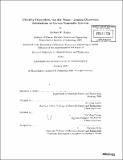Chirality-dependent, van der Waals-London dispersion interactions of carbon nanotube systems
Author(s)
Rajter, Richard F
DownloadFull printable version (102.2Mb)
Alternative title
Chirality-dependent, vdW-Ld interactions of carbon nanotube systems
Other Contributors
Massachusetts Institute of Technology. Dept. of Materials Science and Engineering.
Advisor
W. Craig Carter and Yet-Ming Chiang.
Terms of use
Metadata
Show full item recordAbstract
The Lifshitz formulation is a quantum electrodynamic, first principals formulation used to determine van der Waals - London dispersion interactions in the continuum limit. It has many advantages over crude, pairwise potential models. Most notably, it can solve for complex interactions (e.g. repulsive and multi-body effects) and determine the vdW-Ld interaction magnitude and sign a priori from the optical properties rather than by parameterization. Single wall carbon nanotubes (SWCNTs) represent an ideal class of materials to study vdW-Ld interactions because very small changes in their geometrical construction, via the chirality vector [n,m], can result in vastly different electronic and optical properties. These chirality-dependent optical properties ultimately lead to experimentally exploitable vdW-Ld interactions, which already exist in the literature.Proper use of the Lifshitz formulation requires 1) An analytical extension for the geometry being studied 2) The optical properties of all materials present and 3) A method to incorporate spatially varying properties. This infrastructure needed to be developed to study the vdW-Ld interactions of SWCNTs systems because they were unavailable at the onset. The biggest shortfall was the lack of the E" optical properties out to 30+ eV. (cont.) This was solved by using an ab initio method to obtain this data for 63 SWCNTs and a few MWCNTs. The results showed a clear chirality AND direction dependence that is unique to each [n,m]. Lifshitz and spectral mixing formulations were then derived and introduced respectively for obtaining accurate Hamaker coefficients and vdW-Ld total energies for these optically anisotropic SWCNTs at both the near and far-limits. With the infrastructure in place, it was now possible to study the trends and breakdowns over a large population as a function of SWCNT class and chirality. A thorough analysis of all these properties at all levels of abstraction yielded a new classification system specific to the vdW-Ld properties of SWCNTs. Additionally, the use of this data and an understanding of the qualitative trends makes it straightforward to design experiments that target, trap, and/or separate specific SWCNTs as a function of SWCNT class, radius, etc.
Description
Thesis (Ph. D.)--Massachusetts Institute of Technology, Dept. of Materials Science and Engineering, 2009. Includes bibliographical references (p. 185-192).
Date issued
2009Department
Massachusetts Institute of Technology. Department of Materials Science and EngineeringPublisher
Massachusetts Institute of Technology
Keywords
Materials Science and Engineering.